MKT550 - Global Marketing Assessment: AB's Honey's Indian Market Plan
VerifiedAdded on 2020/11/02
|15
|4069
|72
Report
AI Summary
This marketing plan, developed for MKT550, focuses on AB's Honey's expansion into the Indian market. It begins with an executive summary and table of contents, followed by a detailed business environment analysis using the PESTEL framework. The report includes market and competitor analyses, organizational assets and skills, and a SWOT analysis to identify strengths, weaknesses, opportunities, and threats. It explores various market entry options, with a preference for licensing. The plan outlines the STP approach, defines marketing objectives, and details the marketing mix strategy, including product, price, place, promotion, people, process, and physical evidence. The plan concludes with implementation and control strategies, providing a comprehensive overview of AB's Honey's approach to the Indian market, referencing APA style.
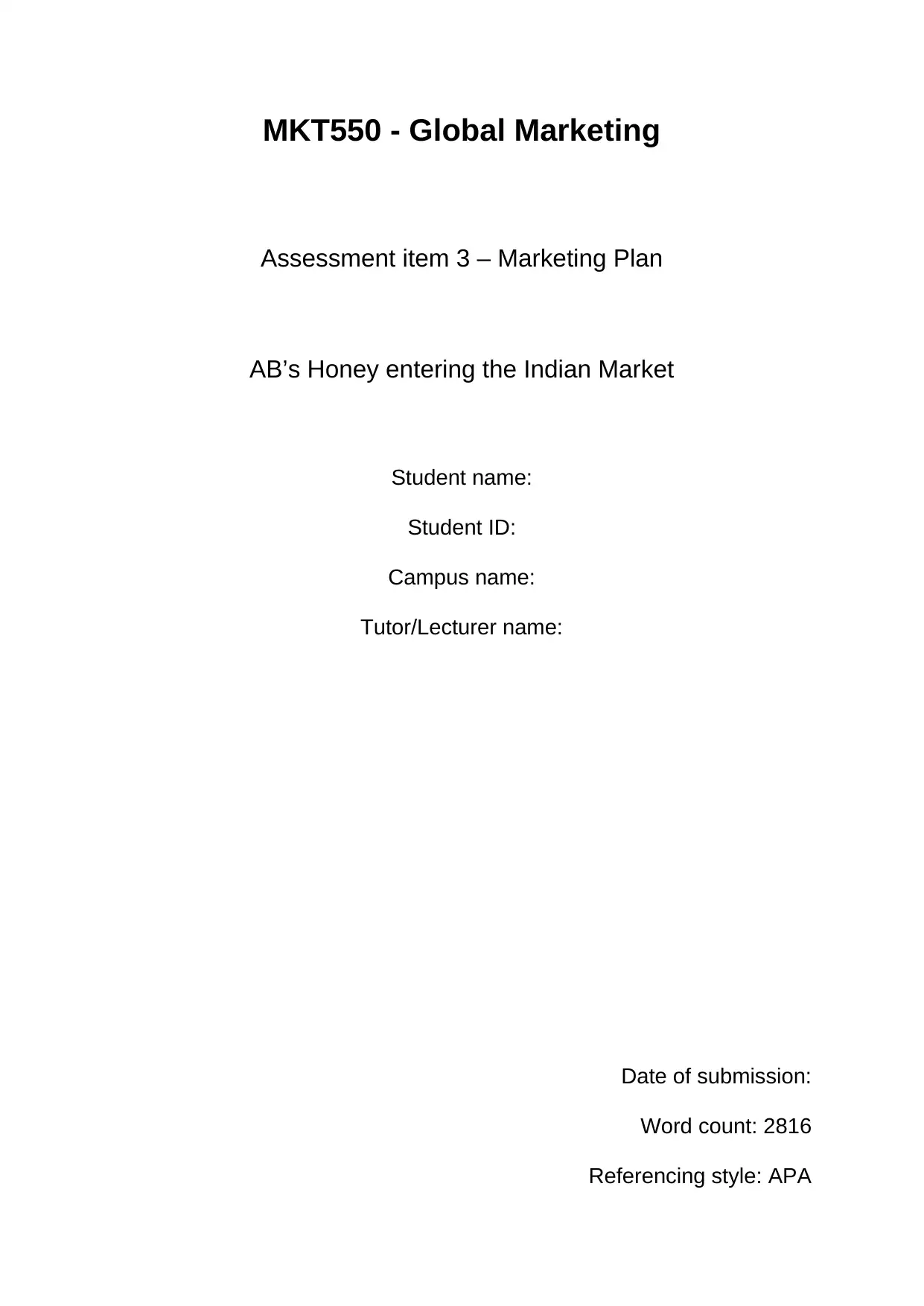
MKT550 - Global Marketing
Assessment item 3 – Marketing Plan
AB’s Honey entering the Indian Market
Student name:
Student ID:
Campus name:
Tutor/Lecturer name:
Date of submission:
Word count: 2816
Referencing style: APA
Assessment item 3 – Marketing Plan
AB’s Honey entering the Indian Market
Student name:
Student ID:
Campus name:
Tutor/Lecturer name:
Date of submission:
Word count: 2816
Referencing style: APA
Paraphrase This Document
Need a fresh take? Get an instant paraphrase of this document with our AI Paraphraser
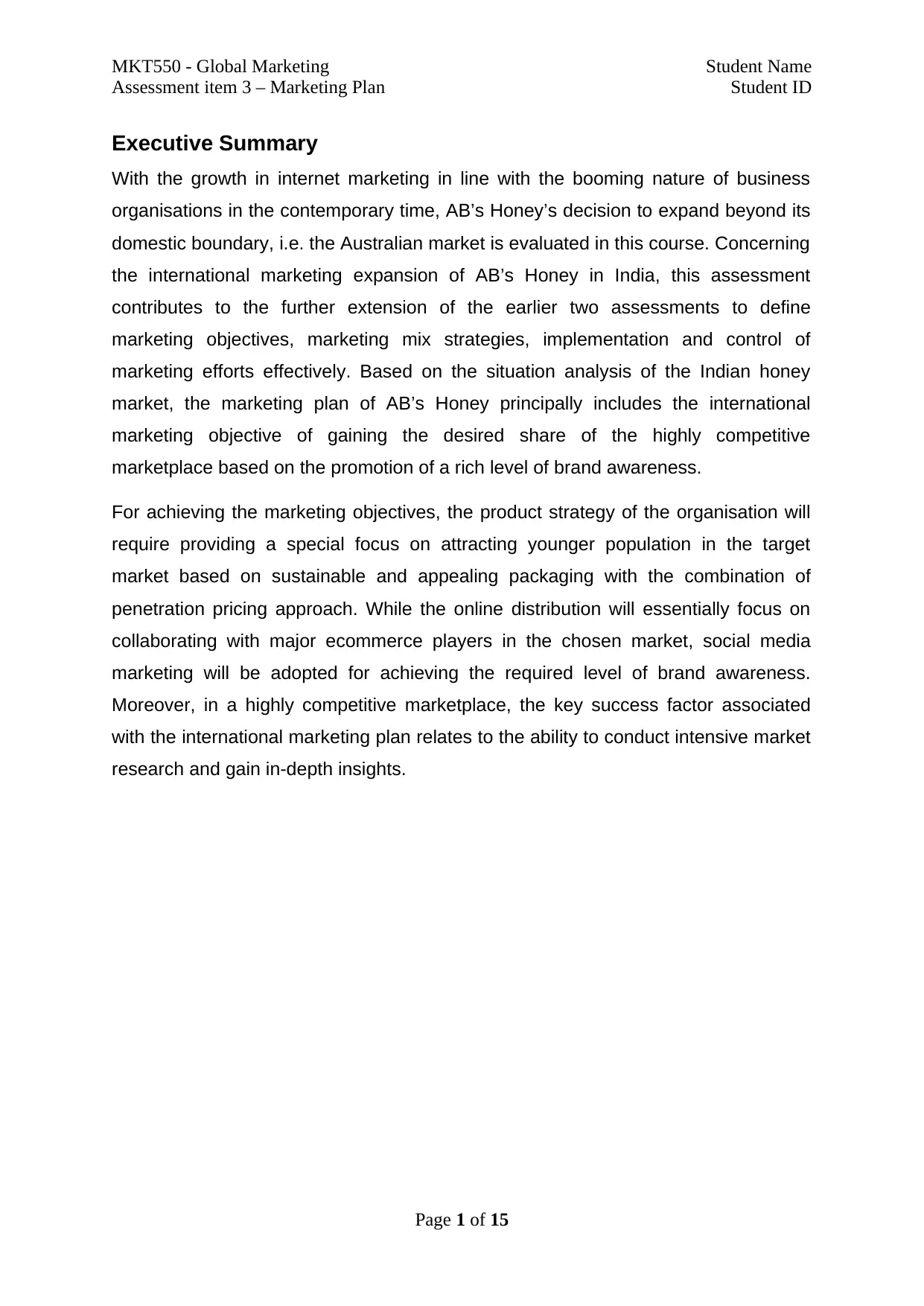
MKT550 - Global Marketing Student Name
Assessment item 3 – Marketing Plan Student ID
Executive Summary
With the growth in internet marketing in line with the booming nature of business
organisations in the contemporary time, AB’s Honey’s decision to expand beyond its
domestic boundary, i.e. the Australian market is evaluated in this course. Concerning
the international marketing expansion of AB’s Honey in India, this assessment
contributes to the further extension of the earlier two assessments to define
marketing objectives, marketing mix strategies, implementation and control of
marketing efforts effectively. Based on the situation analysis of the Indian honey
market, the marketing plan of AB’s Honey principally includes the international
marketing objective of gaining the desired share of the highly competitive
marketplace based on the promotion of a rich level of brand awareness.
For achieving the marketing objectives, the product strategy of the organisation will
require providing a special focus on attracting younger population in the target
market based on sustainable and appealing packaging with the combination of
penetration pricing approach. While the online distribution will essentially focus on
collaborating with major ecommerce players in the chosen market, social media
marketing will be adopted for achieving the required level of brand awareness.
Moreover, in a highly competitive marketplace, the key success factor associated
with the international marketing plan relates to the ability to conduct intensive market
research and gain in-depth insights.
Page 1 of 15
Assessment item 3 – Marketing Plan Student ID
Executive Summary
With the growth in internet marketing in line with the booming nature of business
organisations in the contemporary time, AB’s Honey’s decision to expand beyond its
domestic boundary, i.e. the Australian market is evaluated in this course. Concerning
the international marketing expansion of AB’s Honey in India, this assessment
contributes to the further extension of the earlier two assessments to define
marketing objectives, marketing mix strategies, implementation and control of
marketing efforts effectively. Based on the situation analysis of the Indian honey
market, the marketing plan of AB’s Honey principally includes the international
marketing objective of gaining the desired share of the highly competitive
marketplace based on the promotion of a rich level of brand awareness.
For achieving the marketing objectives, the product strategy of the organisation will
require providing a special focus on attracting younger population in the target
market based on sustainable and appealing packaging with the combination of
penetration pricing approach. While the online distribution will essentially focus on
collaborating with major ecommerce players in the chosen market, social media
marketing will be adopted for achieving the required level of brand awareness.
Moreover, in a highly competitive marketplace, the key success factor associated
with the international marketing plan relates to the ability to conduct intensive market
research and gain in-depth insights.
Page 1 of 15
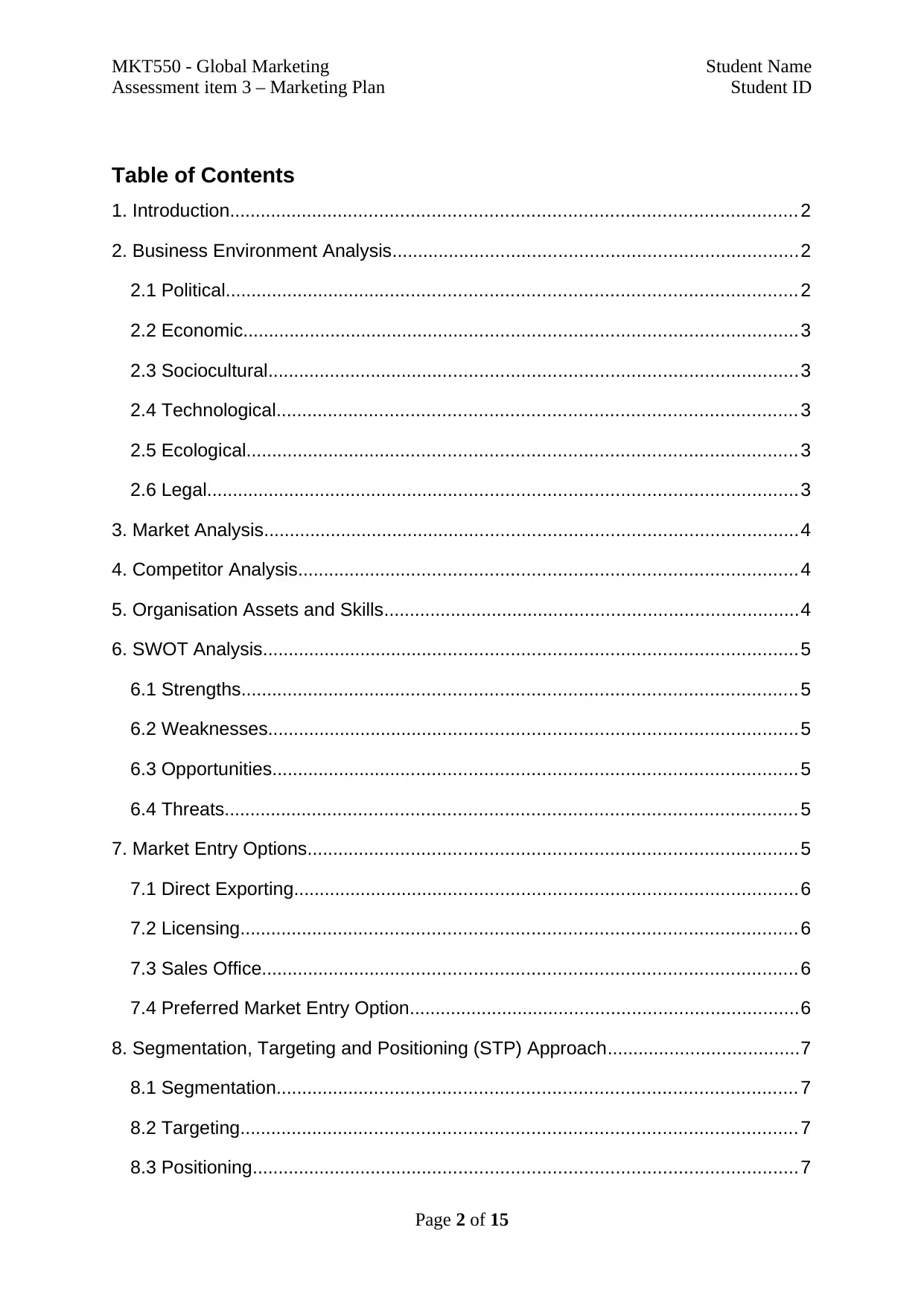
MKT550 - Global Marketing Student Name
Assessment item 3 – Marketing Plan Student ID
Table of Contents
1. Introduction............................................................................................................. 2
2. Business Environment Analysis..............................................................................2
2.1 Political..............................................................................................................2
2.2 Economic...........................................................................................................3
2.3 Sociocultural......................................................................................................3
2.4 Technological.................................................................................................... 3
2.5 Ecological.......................................................................................................... 3
2.6 Legal..................................................................................................................3
3. Market Analysis.......................................................................................................4
4. Competitor Analysis................................................................................................4
5. Organisation Assets and Skills................................................................................4
6. SWOT Analysis.......................................................................................................5
6.1 Strengths........................................................................................................... 5
6.2 Weaknesses......................................................................................................5
6.3 Opportunities..................................................................................................... 5
6.4 Threats.............................................................................................................. 5
7. Market Entry Options.............................................................................................. 5
7.1 Direct Exporting.................................................................................................6
7.2 Licensing........................................................................................................... 6
7.3 Sales Office....................................................................................................... 6
7.4 Preferred Market Entry Option...........................................................................6
8. Segmentation, Targeting and Positioning (STP) Approach.....................................7
8.1 Segmentation.................................................................................................... 7
8.2 Targeting........................................................................................................... 7
8.3 Positioning.........................................................................................................7
Page 2 of 15
Assessment item 3 – Marketing Plan Student ID
Table of Contents
1. Introduction............................................................................................................. 2
2. Business Environment Analysis..............................................................................2
2.1 Political..............................................................................................................2
2.2 Economic...........................................................................................................3
2.3 Sociocultural......................................................................................................3
2.4 Technological.................................................................................................... 3
2.5 Ecological.......................................................................................................... 3
2.6 Legal..................................................................................................................3
3. Market Analysis.......................................................................................................4
4. Competitor Analysis................................................................................................4
5. Organisation Assets and Skills................................................................................4
6. SWOT Analysis.......................................................................................................5
6.1 Strengths........................................................................................................... 5
6.2 Weaknesses......................................................................................................5
6.3 Opportunities..................................................................................................... 5
6.4 Threats.............................................................................................................. 5
7. Market Entry Options.............................................................................................. 5
7.1 Direct Exporting.................................................................................................6
7.2 Licensing........................................................................................................... 6
7.3 Sales Office....................................................................................................... 6
7.4 Preferred Market Entry Option...........................................................................6
8. Segmentation, Targeting and Positioning (STP) Approach.....................................7
8.1 Segmentation.................................................................................................... 7
8.2 Targeting........................................................................................................... 7
8.3 Positioning.........................................................................................................7
Page 2 of 15
⊘ This is a preview!⊘
Do you want full access?
Subscribe today to unlock all pages.

Trusted by 1+ million students worldwide
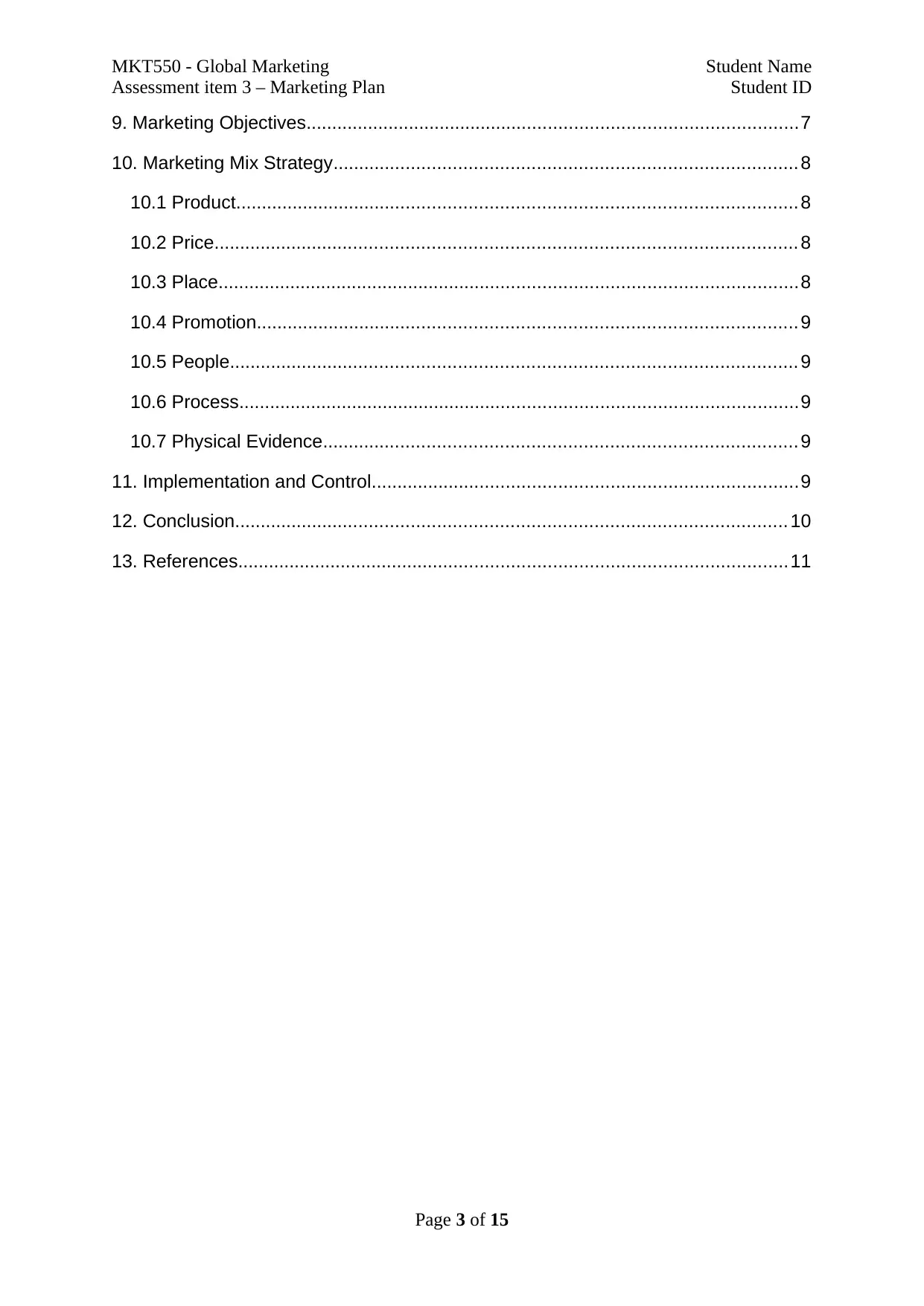
MKT550 - Global Marketing Student Name
Assessment item 3 – Marketing Plan Student ID
9. Marketing Objectives...............................................................................................7
10. Marketing Mix Strategy.........................................................................................8
10.1 Product............................................................................................................8
10.2 Price................................................................................................................ 8
10.3 Place................................................................................................................8
10.4 Promotion........................................................................................................ 9
10.5 People............................................................................................................. 9
10.6 Process............................................................................................................9
10.7 Physical Evidence........................................................................................... 9
11. Implementation and Control..................................................................................9
12. Conclusion.......................................................................................................... 10
13. References..........................................................................................................11
Page 3 of 15
Assessment item 3 – Marketing Plan Student ID
9. Marketing Objectives...............................................................................................7
10. Marketing Mix Strategy.........................................................................................8
10.1 Product............................................................................................................8
10.2 Price................................................................................................................ 8
10.3 Place................................................................................................................8
10.4 Promotion........................................................................................................ 9
10.5 People............................................................................................................. 9
10.6 Process............................................................................................................9
10.7 Physical Evidence........................................................................................... 9
11. Implementation and Control..................................................................................9
12. Conclusion.......................................................................................................... 10
13. References..........................................................................................................11
Page 3 of 15
Paraphrase This Document
Need a fresh take? Get an instant paraphrase of this document with our AI Paraphraser
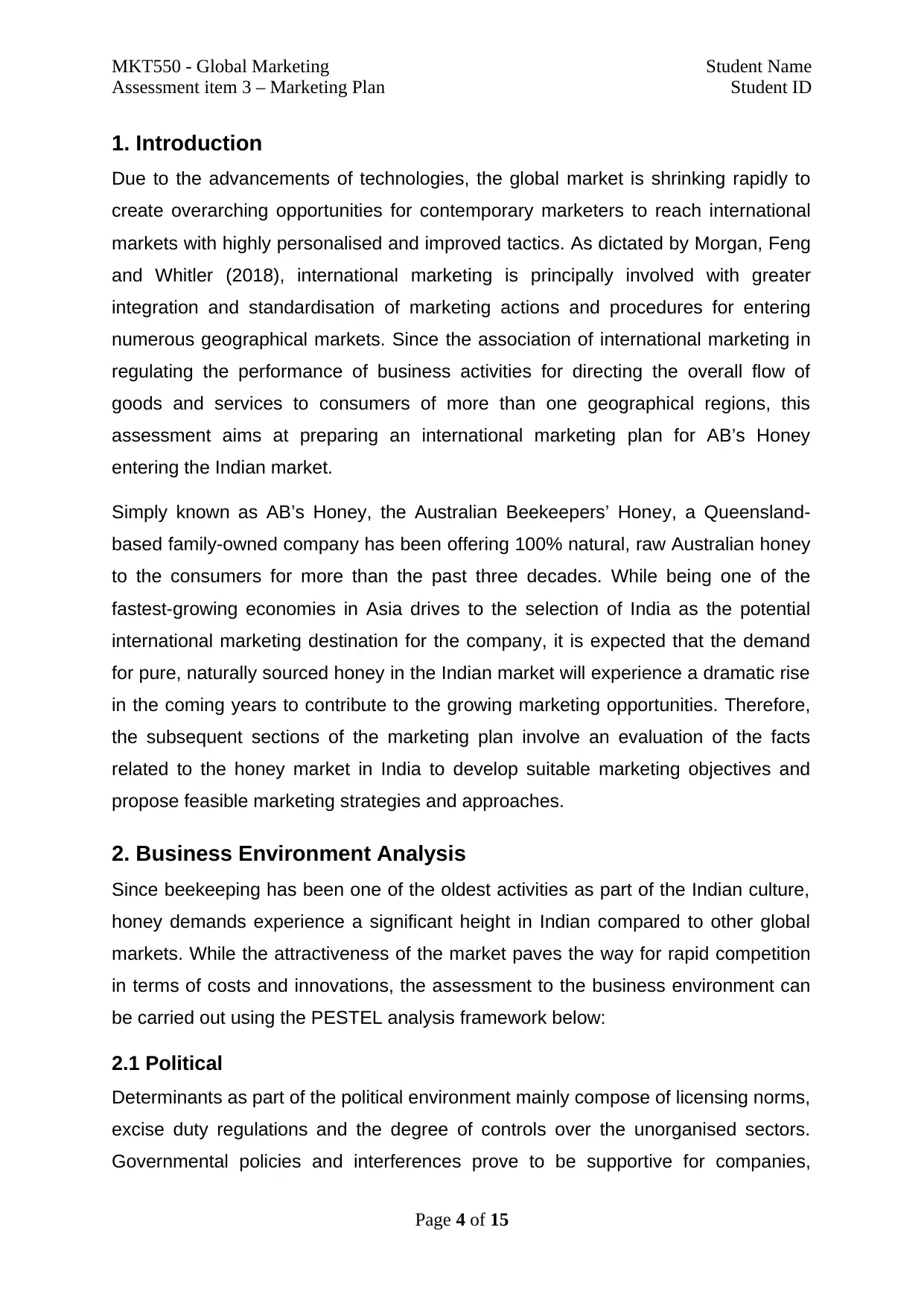
MKT550 - Global Marketing Student Name
Assessment item 3 – Marketing Plan Student ID
1. Introduction
Due to the advancements of technologies, the global market is shrinking rapidly to
create overarching opportunities for contemporary marketers to reach international
markets with highly personalised and improved tactics. As dictated by Morgan, Feng
and Whitler (2018), international marketing is principally involved with greater
integration and standardisation of marketing actions and procedures for entering
numerous geographical markets. Since the association of international marketing in
regulating the performance of business activities for directing the overall flow of
goods and services to consumers of more than one geographical regions, this
assessment aims at preparing an international marketing plan for AB’s Honey
entering the Indian market.
Simply known as AB’s Honey, the Australian Beekeepers’ Honey, a Queensland-
based family-owned company has been offering 100% natural, raw Australian honey
to the consumers for more than the past three decades. While being one of the
fastest-growing economies in Asia drives to the selection of India as the potential
international marketing destination for the company, it is expected that the demand
for pure, naturally sourced honey in the Indian market will experience a dramatic rise
in the coming years to contribute to the growing marketing opportunities. Therefore,
the subsequent sections of the marketing plan involve an evaluation of the facts
related to the honey market in India to develop suitable marketing objectives and
propose feasible marketing strategies and approaches.
2. Business Environment Analysis
Since beekeeping has been one of the oldest activities as part of the Indian culture,
honey demands experience a significant height in Indian compared to other global
markets. While the attractiveness of the market paves the way for rapid competition
in terms of costs and innovations, the assessment to the business environment can
be carried out using the PESTEL analysis framework below:
2.1 Political
Determinants as part of the political environment mainly compose of licensing norms,
excise duty regulations and the degree of controls over the unorganised sectors.
Governmental policies and interferences prove to be supportive for companies,
Page 4 of 15
Assessment item 3 – Marketing Plan Student ID
1. Introduction
Due to the advancements of technologies, the global market is shrinking rapidly to
create overarching opportunities for contemporary marketers to reach international
markets with highly personalised and improved tactics. As dictated by Morgan, Feng
and Whitler (2018), international marketing is principally involved with greater
integration and standardisation of marketing actions and procedures for entering
numerous geographical markets. Since the association of international marketing in
regulating the performance of business activities for directing the overall flow of
goods and services to consumers of more than one geographical regions, this
assessment aims at preparing an international marketing plan for AB’s Honey
entering the Indian market.
Simply known as AB’s Honey, the Australian Beekeepers’ Honey, a Queensland-
based family-owned company has been offering 100% natural, raw Australian honey
to the consumers for more than the past three decades. While being one of the
fastest-growing economies in Asia drives to the selection of India as the potential
international marketing destination for the company, it is expected that the demand
for pure, naturally sourced honey in the Indian market will experience a dramatic rise
in the coming years to contribute to the growing marketing opportunities. Therefore,
the subsequent sections of the marketing plan involve an evaluation of the facts
related to the honey market in India to develop suitable marketing objectives and
propose feasible marketing strategies and approaches.
2. Business Environment Analysis
Since beekeeping has been one of the oldest activities as part of the Indian culture,
honey demands experience a significant height in Indian compared to other global
markets. While the attractiveness of the market paves the way for rapid competition
in terms of costs and innovations, the assessment to the business environment can
be carried out using the PESTEL analysis framework below:
2.1 Political
Determinants as part of the political environment mainly compose of licensing norms,
excise duty regulations and the degree of controls over the unorganised sectors.
Governmental policies and interferences prove to be supportive for companies,
Page 4 of 15
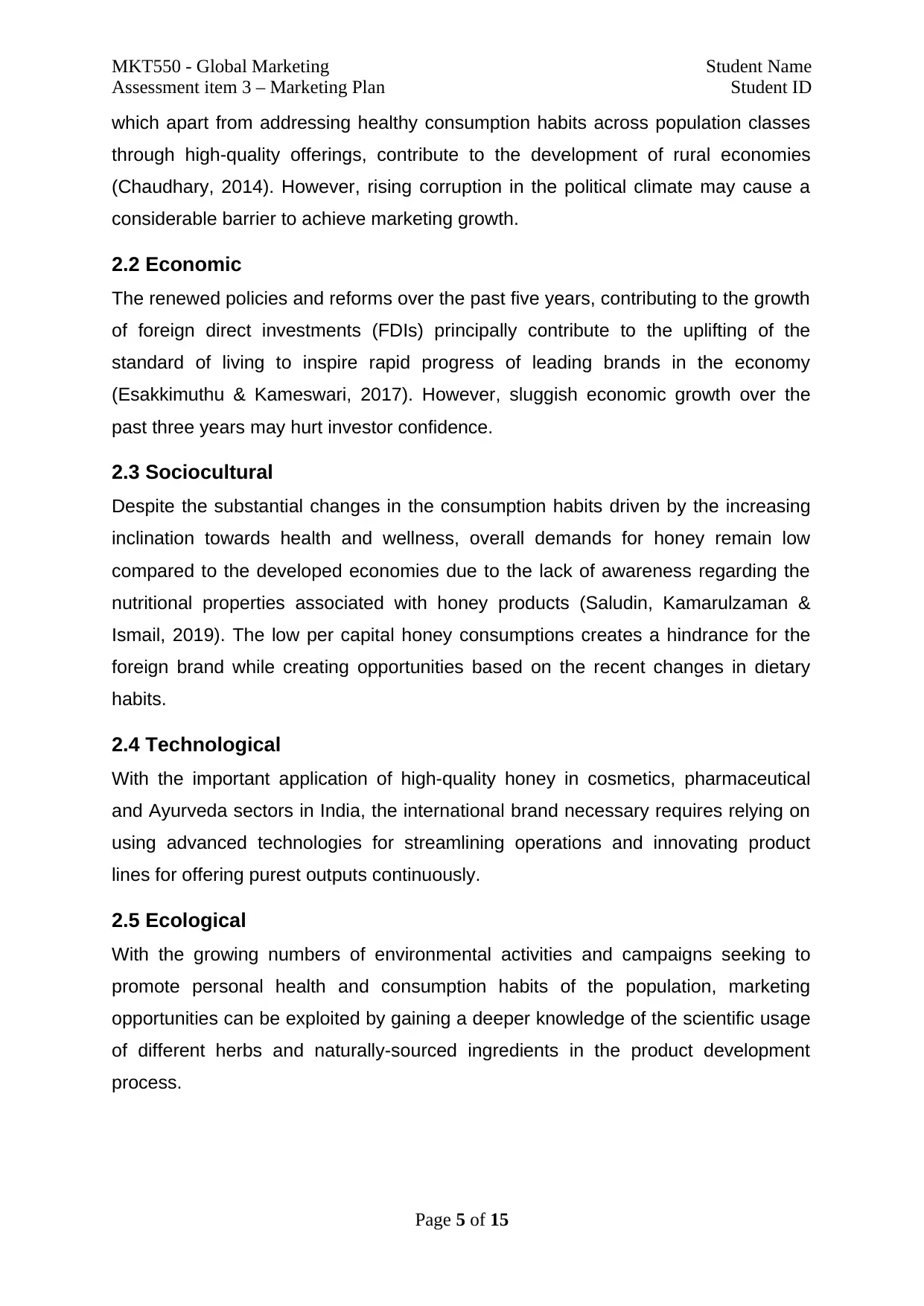
MKT550 - Global Marketing Student Name
Assessment item 3 – Marketing Plan Student ID
which apart from addressing healthy consumption habits across population classes
through high-quality offerings, contribute to the development of rural economies
(Chaudhary, 2014). However, rising corruption in the political climate may cause a
considerable barrier to achieve marketing growth.
2.2 Economic
The renewed policies and reforms over the past five years, contributing to the growth
of foreign direct investments (FDIs) principally contribute to the uplifting of the
standard of living to inspire rapid progress of leading brands in the economy
(Esakkimuthu & Kameswari, 2017). However, sluggish economic growth over the
past three years may hurt investor confidence.
2.3 Sociocultural
Despite the substantial changes in the consumption habits driven by the increasing
inclination towards health and wellness, overall demands for honey remain low
compared to the developed economies due to the lack of awareness regarding the
nutritional properties associated with honey products (Saludin, Kamarulzaman &
Ismail, 2019). The low per capital honey consumptions creates a hindrance for the
foreign brand while creating opportunities based on the recent changes in dietary
habits.
2.4 Technological
With the important application of high-quality honey in cosmetics, pharmaceutical
and Ayurveda sectors in India, the international brand necessary requires relying on
using advanced technologies for streamlining operations and innovating product
lines for offering purest outputs continuously.
2.5 Ecological
With the growing numbers of environmental activities and campaigns seeking to
promote personal health and consumption habits of the population, marketing
opportunities can be exploited by gaining a deeper knowledge of the scientific usage
of different herbs and naturally-sourced ingredients in the product development
process.
Page 5 of 15
Assessment item 3 – Marketing Plan Student ID
which apart from addressing healthy consumption habits across population classes
through high-quality offerings, contribute to the development of rural economies
(Chaudhary, 2014). However, rising corruption in the political climate may cause a
considerable barrier to achieve marketing growth.
2.2 Economic
The renewed policies and reforms over the past five years, contributing to the growth
of foreign direct investments (FDIs) principally contribute to the uplifting of the
standard of living to inspire rapid progress of leading brands in the economy
(Esakkimuthu & Kameswari, 2017). However, sluggish economic growth over the
past three years may hurt investor confidence.
2.3 Sociocultural
Despite the substantial changes in the consumption habits driven by the increasing
inclination towards health and wellness, overall demands for honey remain low
compared to the developed economies due to the lack of awareness regarding the
nutritional properties associated with honey products (Saludin, Kamarulzaman &
Ismail, 2019). The low per capital honey consumptions creates a hindrance for the
foreign brand while creating opportunities based on the recent changes in dietary
habits.
2.4 Technological
With the important application of high-quality honey in cosmetics, pharmaceutical
and Ayurveda sectors in India, the international brand necessary requires relying on
using advanced technologies for streamlining operations and innovating product
lines for offering purest outputs continuously.
2.5 Ecological
With the growing numbers of environmental activities and campaigns seeking to
promote personal health and consumption habits of the population, marketing
opportunities can be exploited by gaining a deeper knowledge of the scientific usage
of different herbs and naturally-sourced ingredients in the product development
process.
Page 5 of 15
⊘ This is a preview!⊘
Do you want full access?
Subscribe today to unlock all pages.

Trusted by 1+ million students worldwide
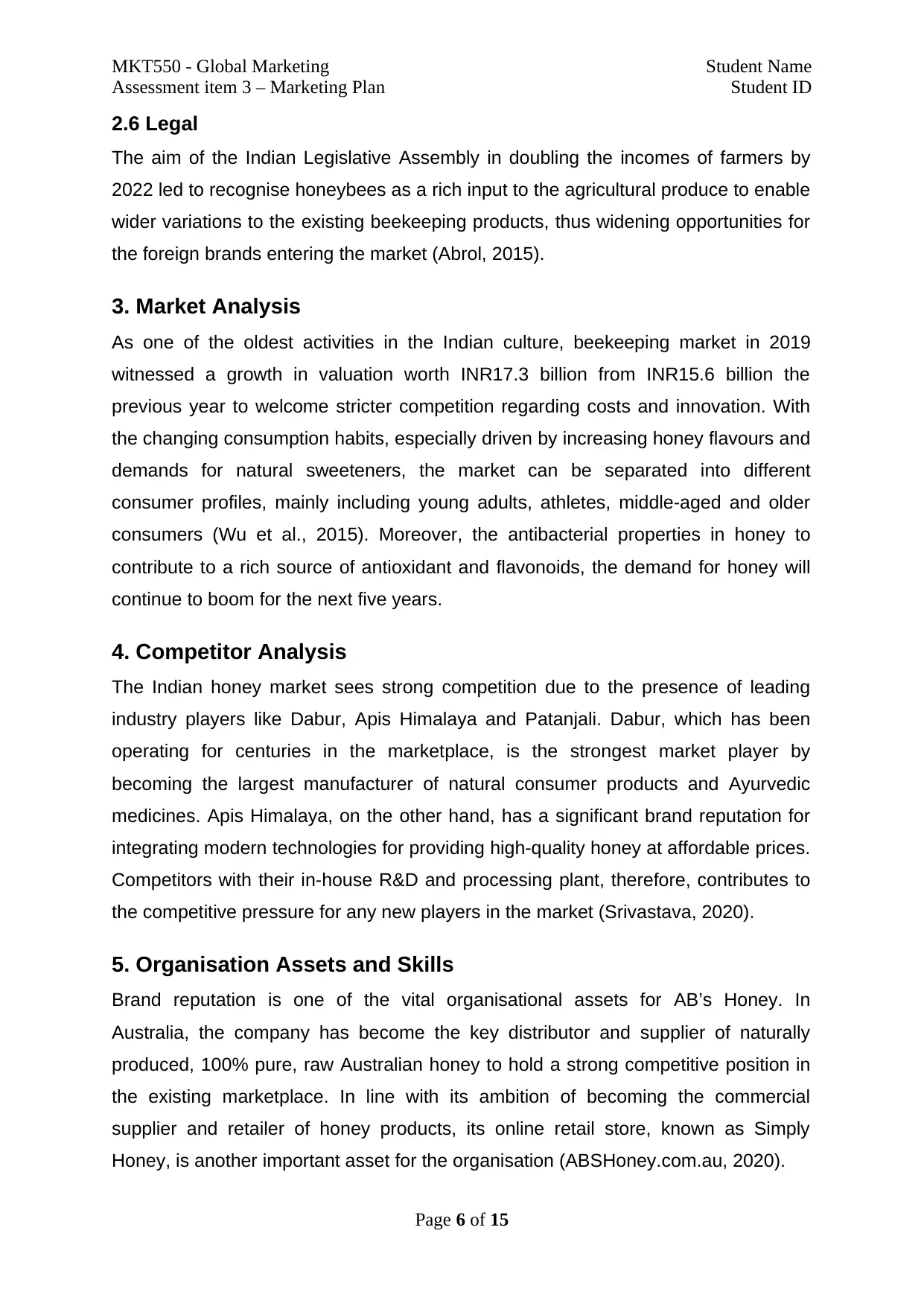
MKT550 - Global Marketing Student Name
Assessment item 3 – Marketing Plan Student ID
2.6 Legal
The aim of the Indian Legislative Assembly in doubling the incomes of farmers by
2022 led to recognise honeybees as a rich input to the agricultural produce to enable
wider variations to the existing beekeeping products, thus widening opportunities for
the foreign brands entering the market (Abrol, 2015).
3. Market Analysis
As one of the oldest activities in the Indian culture, beekeeping market in 2019
witnessed a growth in valuation worth INR17.3 billion from INR15.6 billion the
previous year to welcome stricter competition regarding costs and innovation. With
the changing consumption habits, especially driven by increasing honey flavours and
demands for natural sweeteners, the market can be separated into different
consumer profiles, mainly including young adults, athletes, middle-aged and older
consumers (Wu et al., 2015). Moreover, the antibacterial properties in honey to
contribute to a rich source of antioxidant and flavonoids, the demand for honey will
continue to boom for the next five years.
4. Competitor Analysis
The Indian honey market sees strong competition due to the presence of leading
industry players like Dabur, Apis Himalaya and Patanjali. Dabur, which has been
operating for centuries in the marketplace, is the strongest market player by
becoming the largest manufacturer of natural consumer products and Ayurvedic
medicines. Apis Himalaya, on the other hand, has a significant brand reputation for
integrating modern technologies for providing high-quality honey at affordable prices.
Competitors with their in-house R&D and processing plant, therefore, contributes to
the competitive pressure for any new players in the market (Srivastava, 2020).
5. Organisation Assets and Skills
Brand reputation is one of the vital organisational assets for AB’s Honey. In
Australia, the company has become the key distributor and supplier of naturally
produced, 100% pure, raw Australian honey to hold a strong competitive position in
the existing marketplace. In line with its ambition of becoming the commercial
supplier and retailer of honey products, its online retail store, known as Simply
Honey, is another important asset for the organisation (ABSHoney.com.au, 2020).
Page 6 of 15
Assessment item 3 – Marketing Plan Student ID
2.6 Legal
The aim of the Indian Legislative Assembly in doubling the incomes of farmers by
2022 led to recognise honeybees as a rich input to the agricultural produce to enable
wider variations to the existing beekeeping products, thus widening opportunities for
the foreign brands entering the market (Abrol, 2015).
3. Market Analysis
As one of the oldest activities in the Indian culture, beekeeping market in 2019
witnessed a growth in valuation worth INR17.3 billion from INR15.6 billion the
previous year to welcome stricter competition regarding costs and innovation. With
the changing consumption habits, especially driven by increasing honey flavours and
demands for natural sweeteners, the market can be separated into different
consumer profiles, mainly including young adults, athletes, middle-aged and older
consumers (Wu et al., 2015). Moreover, the antibacterial properties in honey to
contribute to a rich source of antioxidant and flavonoids, the demand for honey will
continue to boom for the next five years.
4. Competitor Analysis
The Indian honey market sees strong competition due to the presence of leading
industry players like Dabur, Apis Himalaya and Patanjali. Dabur, which has been
operating for centuries in the marketplace, is the strongest market player by
becoming the largest manufacturer of natural consumer products and Ayurvedic
medicines. Apis Himalaya, on the other hand, has a significant brand reputation for
integrating modern technologies for providing high-quality honey at affordable prices.
Competitors with their in-house R&D and processing plant, therefore, contributes to
the competitive pressure for any new players in the market (Srivastava, 2020).
5. Organisation Assets and Skills
Brand reputation is one of the vital organisational assets for AB’s Honey. In
Australia, the company has become the key distributor and supplier of naturally
produced, 100% pure, raw Australian honey to hold a strong competitive position in
the existing marketplace. In line with its ambition of becoming the commercial
supplier and retailer of honey products, its online retail store, known as Simply
Honey, is another important asset for the organisation (ABSHoney.com.au, 2020).
Page 6 of 15
Paraphrase This Document
Need a fresh take? Get an instant paraphrase of this document with our AI Paraphraser
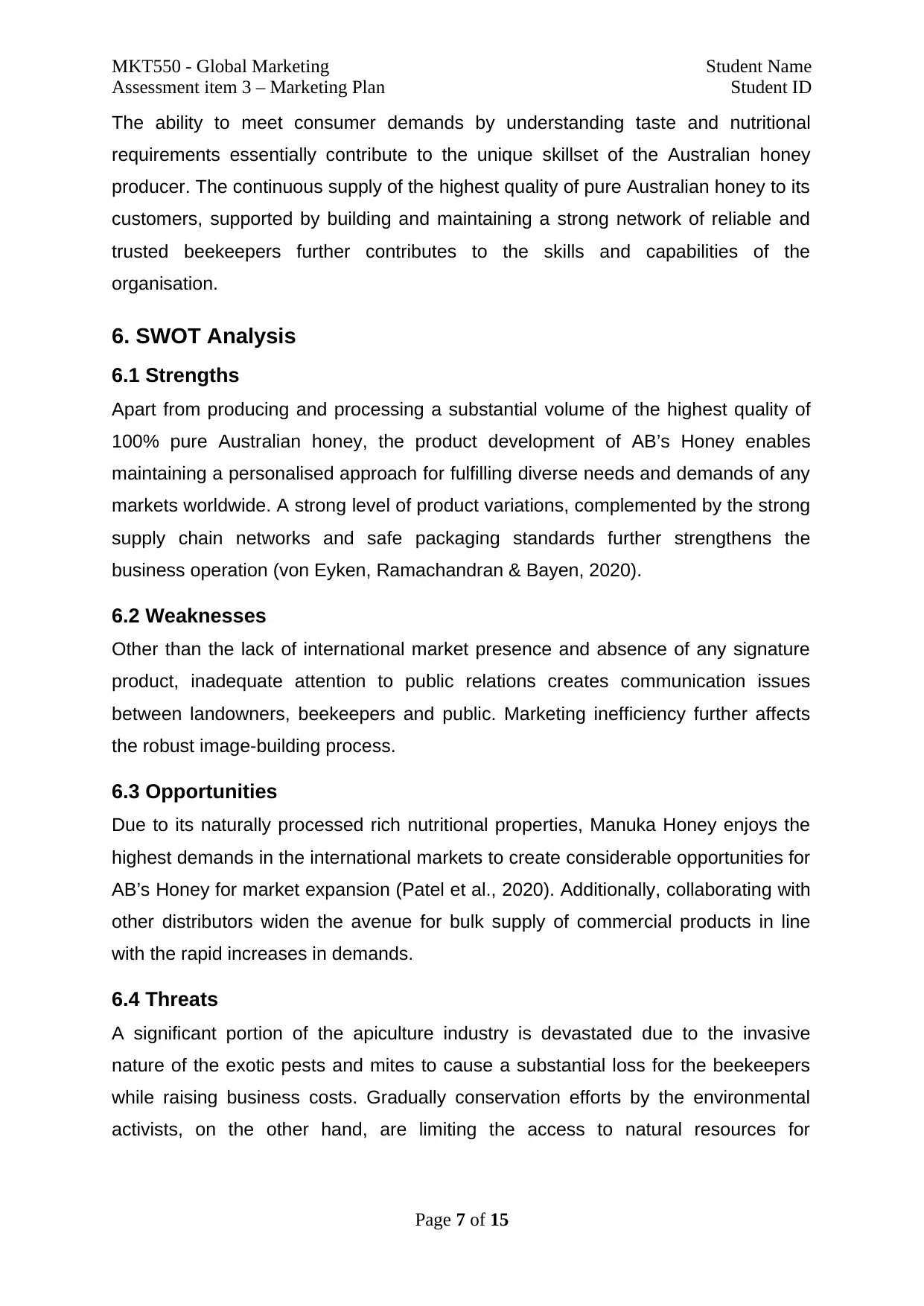
MKT550 - Global Marketing Student Name
Assessment item 3 – Marketing Plan Student ID
The ability to meet consumer demands by understanding taste and nutritional
requirements essentially contribute to the unique skillset of the Australian honey
producer. The continuous supply of the highest quality of pure Australian honey to its
customers, supported by building and maintaining a strong network of reliable and
trusted beekeepers further contributes to the skills and capabilities of the
organisation.
6. SWOT Analysis
6.1 Strengths
Apart from producing and processing a substantial volume of the highest quality of
100% pure Australian honey, the product development of AB’s Honey enables
maintaining a personalised approach for fulfilling diverse needs and demands of any
markets worldwide. A strong level of product variations, complemented by the strong
supply chain networks and safe packaging standards further strengthens the
business operation (von Eyken, Ramachandran & Bayen, 2020).
6.2 Weaknesses
Other than the lack of international market presence and absence of any signature
product, inadequate attention to public relations creates communication issues
between landowners, beekeepers and public. Marketing inefficiency further affects
the robust image-building process.
6.3 Opportunities
Due to its naturally processed rich nutritional properties, Manuka Honey enjoys the
highest demands in the international markets to create considerable opportunities for
AB’s Honey for market expansion (Patel et al., 2020). Additionally, collaborating with
other distributors widen the avenue for bulk supply of commercial products in line
with the rapid increases in demands.
6.4 Threats
A significant portion of the apiculture industry is devastated due to the invasive
nature of the exotic pests and mites to cause a substantial loss for the beekeepers
while raising business costs. Gradually conservation efforts by the environmental
activists, on the other hand, are limiting the access to natural resources for
Page 7 of 15
Assessment item 3 – Marketing Plan Student ID
The ability to meet consumer demands by understanding taste and nutritional
requirements essentially contribute to the unique skillset of the Australian honey
producer. The continuous supply of the highest quality of pure Australian honey to its
customers, supported by building and maintaining a strong network of reliable and
trusted beekeepers further contributes to the skills and capabilities of the
organisation.
6. SWOT Analysis
6.1 Strengths
Apart from producing and processing a substantial volume of the highest quality of
100% pure Australian honey, the product development of AB’s Honey enables
maintaining a personalised approach for fulfilling diverse needs and demands of any
markets worldwide. A strong level of product variations, complemented by the strong
supply chain networks and safe packaging standards further strengthens the
business operation (von Eyken, Ramachandran & Bayen, 2020).
6.2 Weaknesses
Other than the lack of international market presence and absence of any signature
product, inadequate attention to public relations creates communication issues
between landowners, beekeepers and public. Marketing inefficiency further affects
the robust image-building process.
6.3 Opportunities
Due to its naturally processed rich nutritional properties, Manuka Honey enjoys the
highest demands in the international markets to create considerable opportunities for
AB’s Honey for market expansion (Patel et al., 2020). Additionally, collaborating with
other distributors widen the avenue for bulk supply of commercial products in line
with the rapid increases in demands.
6.4 Threats
A significant portion of the apiculture industry is devastated due to the invasive
nature of the exotic pests and mites to cause a substantial loss for the beekeepers
while raising business costs. Gradually conservation efforts by the environmental
activists, on the other hand, are limiting the access to natural resources for
Page 7 of 15
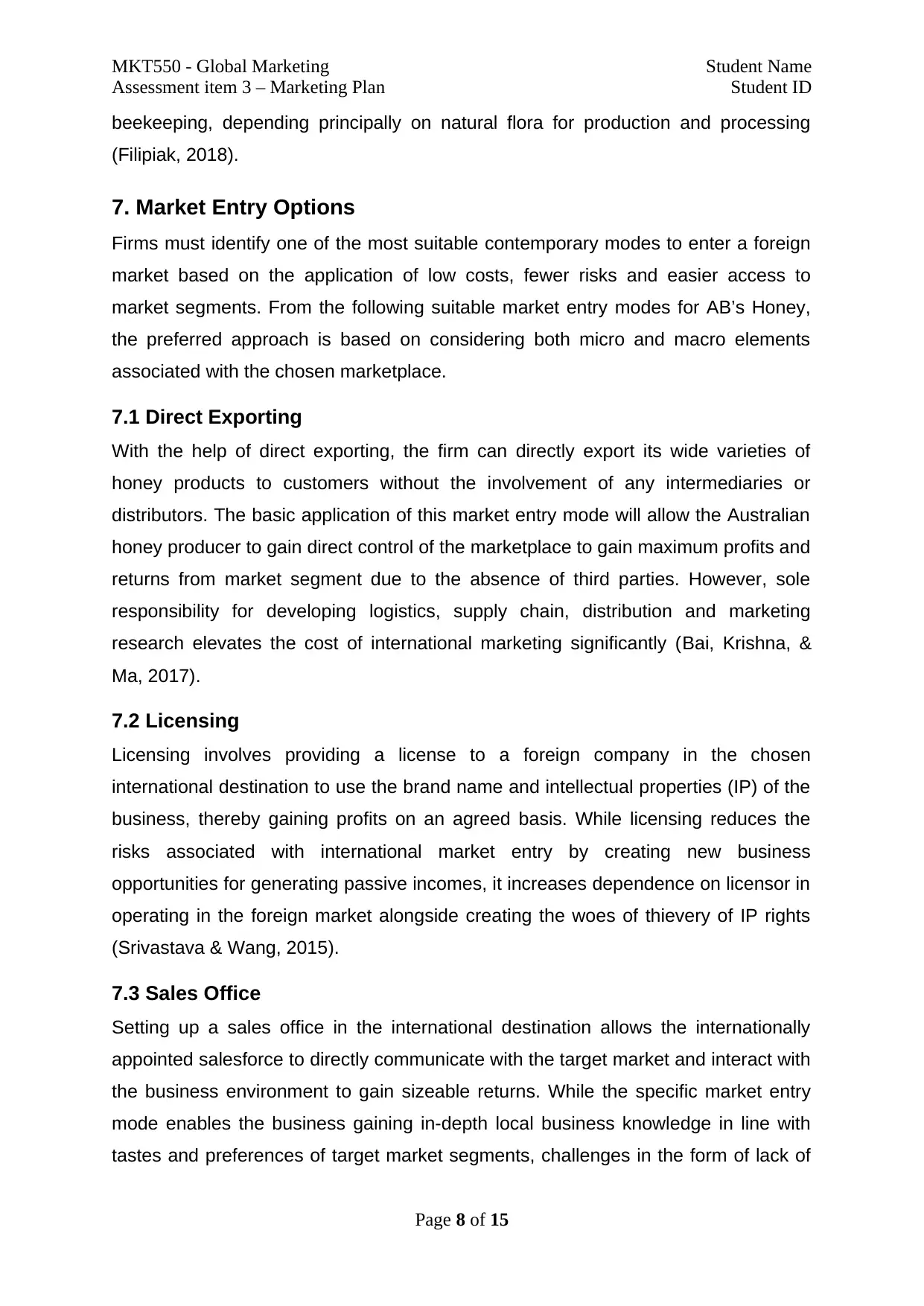
MKT550 - Global Marketing Student Name
Assessment item 3 – Marketing Plan Student ID
beekeeping, depending principally on natural flora for production and processing
(Filipiak, 2018).
7. Market Entry Options
Firms must identify one of the most suitable contemporary modes to enter a foreign
market based on the application of low costs, fewer risks and easier access to
market segments. From the following suitable market entry modes for AB’s Honey,
the preferred approach is based on considering both micro and macro elements
associated with the chosen marketplace.
7.1 Direct Exporting
With the help of direct exporting, the firm can directly export its wide varieties of
honey products to customers without the involvement of any intermediaries or
distributors. The basic application of this market entry mode will allow the Australian
honey producer to gain direct control of the marketplace to gain maximum profits and
returns from market segment due to the absence of third parties. However, sole
responsibility for developing logistics, supply chain, distribution and marketing
research elevates the cost of international marketing significantly (Bai, Krishna, &
Ma, 2017).
7.2 Licensing
Licensing involves providing a license to a foreign company in the chosen
international destination to use the brand name and intellectual properties (IP) of the
business, thereby gaining profits on an agreed basis. While licensing reduces the
risks associated with international market entry by creating new business
opportunities for generating passive incomes, it increases dependence on licensor in
operating in the foreign market alongside creating the woes of thievery of IP rights
(Srivastava & Wang, 2015).
7.3 Sales Office
Setting up a sales office in the international destination allows the internationally
appointed salesforce to directly communicate with the target market and interact with
the business environment to gain sizeable returns. While the specific market entry
mode enables the business gaining in-depth local business knowledge in line with
tastes and preferences of target market segments, challenges in the form of lack of
Page 8 of 15
Assessment item 3 – Marketing Plan Student ID
beekeeping, depending principally on natural flora for production and processing
(Filipiak, 2018).
7. Market Entry Options
Firms must identify one of the most suitable contemporary modes to enter a foreign
market based on the application of low costs, fewer risks and easier access to
market segments. From the following suitable market entry modes for AB’s Honey,
the preferred approach is based on considering both micro and macro elements
associated with the chosen marketplace.
7.1 Direct Exporting
With the help of direct exporting, the firm can directly export its wide varieties of
honey products to customers without the involvement of any intermediaries or
distributors. The basic application of this market entry mode will allow the Australian
honey producer to gain direct control of the marketplace to gain maximum profits and
returns from market segment due to the absence of third parties. However, sole
responsibility for developing logistics, supply chain, distribution and marketing
research elevates the cost of international marketing significantly (Bai, Krishna, &
Ma, 2017).
7.2 Licensing
Licensing involves providing a license to a foreign company in the chosen
international destination to use the brand name and intellectual properties (IP) of the
business, thereby gaining profits on an agreed basis. While licensing reduces the
risks associated with international market entry by creating new business
opportunities for generating passive incomes, it increases dependence on licensor in
operating in the foreign market alongside creating the woes of thievery of IP rights
(Srivastava & Wang, 2015).
7.3 Sales Office
Setting up a sales office in the international destination allows the internationally
appointed salesforce to directly communicate with the target market and interact with
the business environment to gain sizeable returns. While the specific market entry
mode enables the business gaining in-depth local business knowledge in line with
tastes and preferences of target market segments, challenges in the form of lack of
Page 8 of 15
⊘ This is a preview!⊘
Do you want full access?
Subscribe today to unlock all pages.

Trusted by 1+ million students worldwide
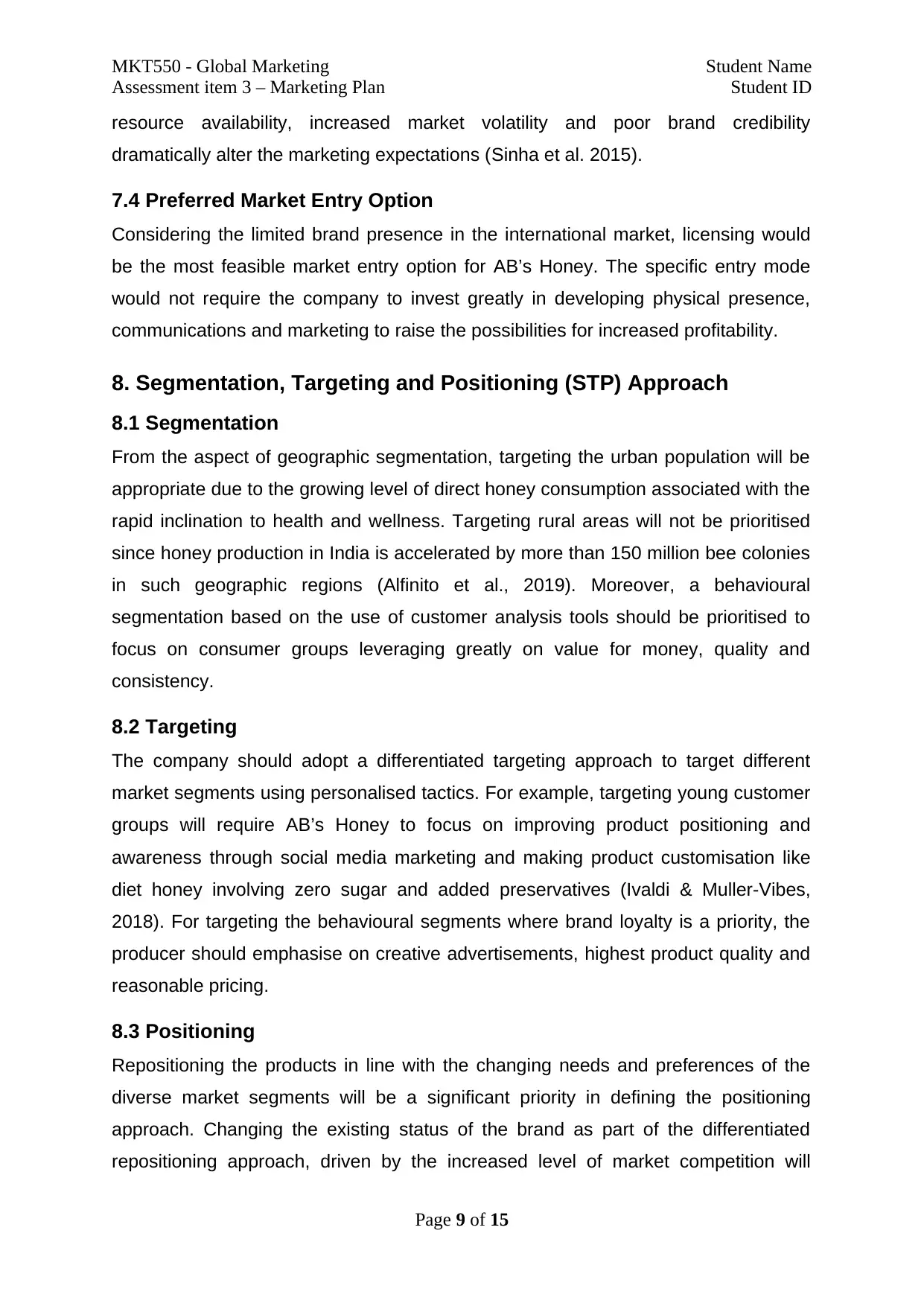
MKT550 - Global Marketing Student Name
Assessment item 3 – Marketing Plan Student ID
resource availability, increased market volatility and poor brand credibility
dramatically alter the marketing expectations (Sinha et al. 2015).
7.4 Preferred Market Entry Option
Considering the limited brand presence in the international market, licensing would
be the most feasible market entry option for AB’s Honey. The specific entry mode
would not require the company to invest greatly in developing physical presence,
communications and marketing to raise the possibilities for increased profitability.
8. Segmentation, Targeting and Positioning (STP) Approach
8.1 Segmentation
From the aspect of geographic segmentation, targeting the urban population will be
appropriate due to the growing level of direct honey consumption associated with the
rapid inclination to health and wellness. Targeting rural areas will not be prioritised
since honey production in India is accelerated by more than 150 million bee colonies
in such geographic regions (Alfinito et al., 2019). Moreover, a behavioural
segmentation based on the use of customer analysis tools should be prioritised to
focus on consumer groups leveraging greatly on value for money, quality and
consistency.
8.2 Targeting
The company should adopt a differentiated targeting approach to target different
market segments using personalised tactics. For example, targeting young customer
groups will require AB’s Honey to focus on improving product positioning and
awareness through social media marketing and making product customisation like
diet honey involving zero sugar and added preservatives (Ivaldi & Muller-Vibes,
2018). For targeting the behavioural segments where brand loyalty is a priority, the
producer should emphasise on creative advertisements, highest product quality and
reasonable pricing.
8.3 Positioning
Repositioning the products in line with the changing needs and preferences of the
diverse market segments will be a significant priority in defining the positioning
approach. Changing the existing status of the brand as part of the differentiated
repositioning approach, driven by the increased level of market competition will
Page 9 of 15
Assessment item 3 – Marketing Plan Student ID
resource availability, increased market volatility and poor brand credibility
dramatically alter the marketing expectations (Sinha et al. 2015).
7.4 Preferred Market Entry Option
Considering the limited brand presence in the international market, licensing would
be the most feasible market entry option for AB’s Honey. The specific entry mode
would not require the company to invest greatly in developing physical presence,
communications and marketing to raise the possibilities for increased profitability.
8. Segmentation, Targeting and Positioning (STP) Approach
8.1 Segmentation
From the aspect of geographic segmentation, targeting the urban population will be
appropriate due to the growing level of direct honey consumption associated with the
rapid inclination to health and wellness. Targeting rural areas will not be prioritised
since honey production in India is accelerated by more than 150 million bee colonies
in such geographic regions (Alfinito et al., 2019). Moreover, a behavioural
segmentation based on the use of customer analysis tools should be prioritised to
focus on consumer groups leveraging greatly on value for money, quality and
consistency.
8.2 Targeting
The company should adopt a differentiated targeting approach to target different
market segments using personalised tactics. For example, targeting young customer
groups will require AB’s Honey to focus on improving product positioning and
awareness through social media marketing and making product customisation like
diet honey involving zero sugar and added preservatives (Ivaldi & Muller-Vibes,
2018). For targeting the behavioural segments where brand loyalty is a priority, the
producer should emphasise on creative advertisements, highest product quality and
reasonable pricing.
8.3 Positioning
Repositioning the products in line with the changing needs and preferences of the
diverse market segments will be a significant priority in defining the positioning
approach. Changing the existing status of the brand as part of the differentiated
repositioning approach, driven by the increased level of market competition will
Page 9 of 15
Paraphrase This Document
Need a fresh take? Get an instant paraphrase of this document with our AI Paraphraser
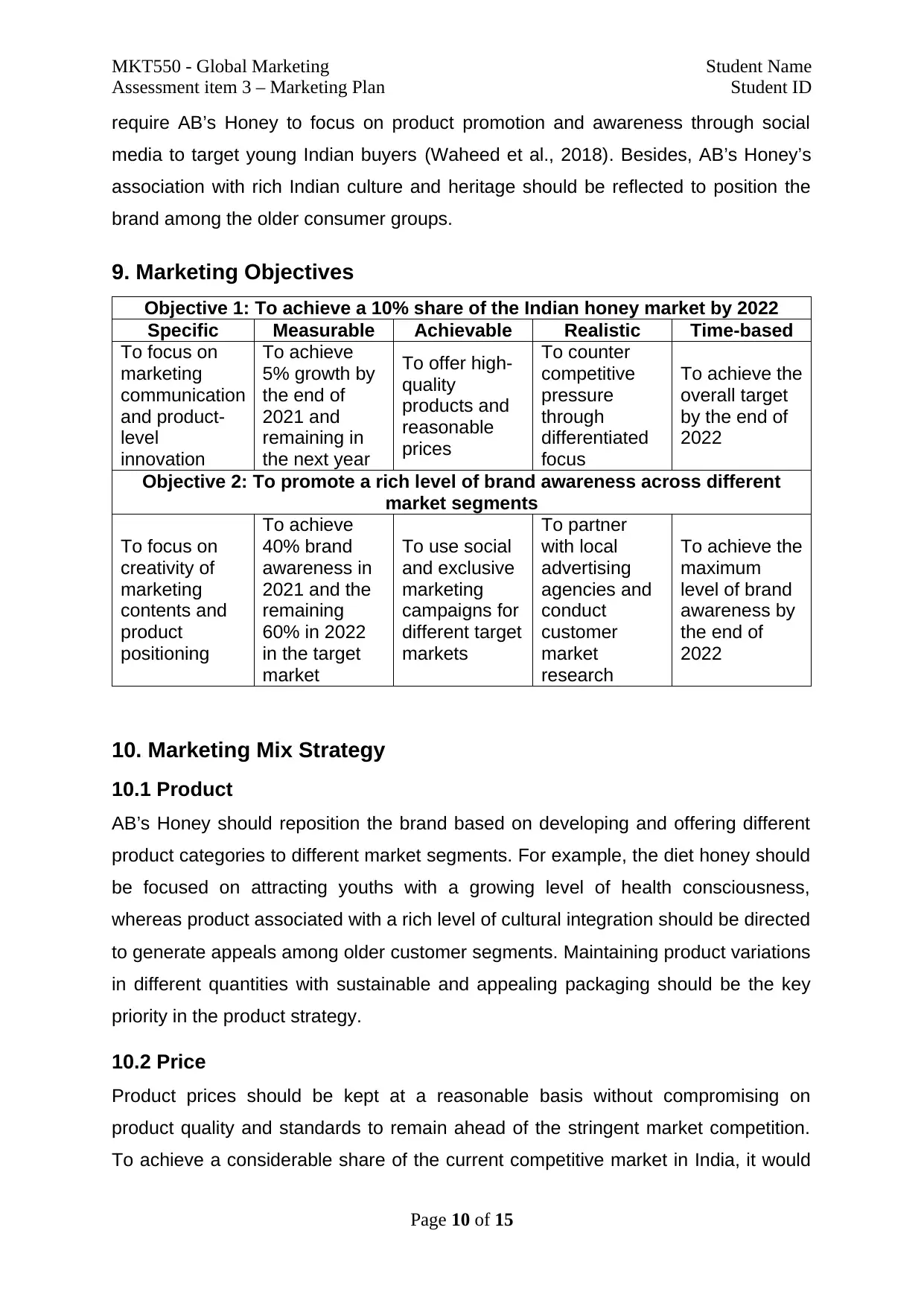
MKT550 - Global Marketing Student Name
Assessment item 3 – Marketing Plan Student ID
require AB’s Honey to focus on product promotion and awareness through social
media to target young Indian buyers (Waheed et al., 2018). Besides, AB’s Honey’s
association with rich Indian culture and heritage should be reflected to position the
brand among the older consumer groups.
9. Marketing Objectives
Objective 1: To achieve a 10% share of the Indian honey market by 2022
Specific Measurable Achievable Realistic Time-based
To focus on
marketing
communication
and product-
level
innovation
To achieve
5% growth by
the end of
2021 and
remaining in
the next year
To offer high-
quality
products and
reasonable
prices
To counter
competitive
pressure
through
differentiated
focus
To achieve the
overall target
by the end of
2022
Objective 2: To promote a rich level of brand awareness across different
market segments
To focus on
creativity of
marketing
contents and
product
positioning
To achieve
40% brand
awareness in
2021 and the
remaining
60% in 2022
in the target
market
To use social
and exclusive
marketing
campaigns for
different target
markets
To partner
with local
advertising
agencies and
conduct
customer
market
research
To achieve the
maximum
level of brand
awareness by
the end of
2022
10. Marketing Mix Strategy
10.1 Product
AB’s Honey should reposition the brand based on developing and offering different
product categories to different market segments. For example, the diet honey should
be focused on attracting youths with a growing level of health consciousness,
whereas product associated with a rich level of cultural integration should be directed
to generate appeals among older customer segments. Maintaining product variations
in different quantities with sustainable and appealing packaging should be the key
priority in the product strategy.
10.2 Price
Product prices should be kept at a reasonable basis without compromising on
product quality and standards to remain ahead of the stringent market competition.
To achieve a considerable share of the current competitive market in India, it would
Page 10 of 15
Assessment item 3 – Marketing Plan Student ID
require AB’s Honey to focus on product promotion and awareness through social
media to target young Indian buyers (Waheed et al., 2018). Besides, AB’s Honey’s
association with rich Indian culture and heritage should be reflected to position the
brand among the older consumer groups.
9. Marketing Objectives
Objective 1: To achieve a 10% share of the Indian honey market by 2022
Specific Measurable Achievable Realistic Time-based
To focus on
marketing
communication
and product-
level
innovation
To achieve
5% growth by
the end of
2021 and
remaining in
the next year
To offer high-
quality
products and
reasonable
prices
To counter
competitive
pressure
through
differentiated
focus
To achieve the
overall target
by the end of
2022
Objective 2: To promote a rich level of brand awareness across different
market segments
To focus on
creativity of
marketing
contents and
product
positioning
To achieve
40% brand
awareness in
2021 and the
remaining
60% in 2022
in the target
market
To use social
and exclusive
marketing
campaigns for
different target
markets
To partner
with local
advertising
agencies and
conduct
customer
market
research
To achieve the
maximum
level of brand
awareness by
the end of
2022
10. Marketing Mix Strategy
10.1 Product
AB’s Honey should reposition the brand based on developing and offering different
product categories to different market segments. For example, the diet honey should
be focused on attracting youths with a growing level of health consciousness,
whereas product associated with a rich level of cultural integration should be directed
to generate appeals among older customer segments. Maintaining product variations
in different quantities with sustainable and appealing packaging should be the key
priority in the product strategy.
10.2 Price
Product prices should be kept at a reasonable basis without compromising on
product quality and standards to remain ahead of the stringent market competition.
To achieve a considerable share of the current competitive market in India, it would
Page 10 of 15
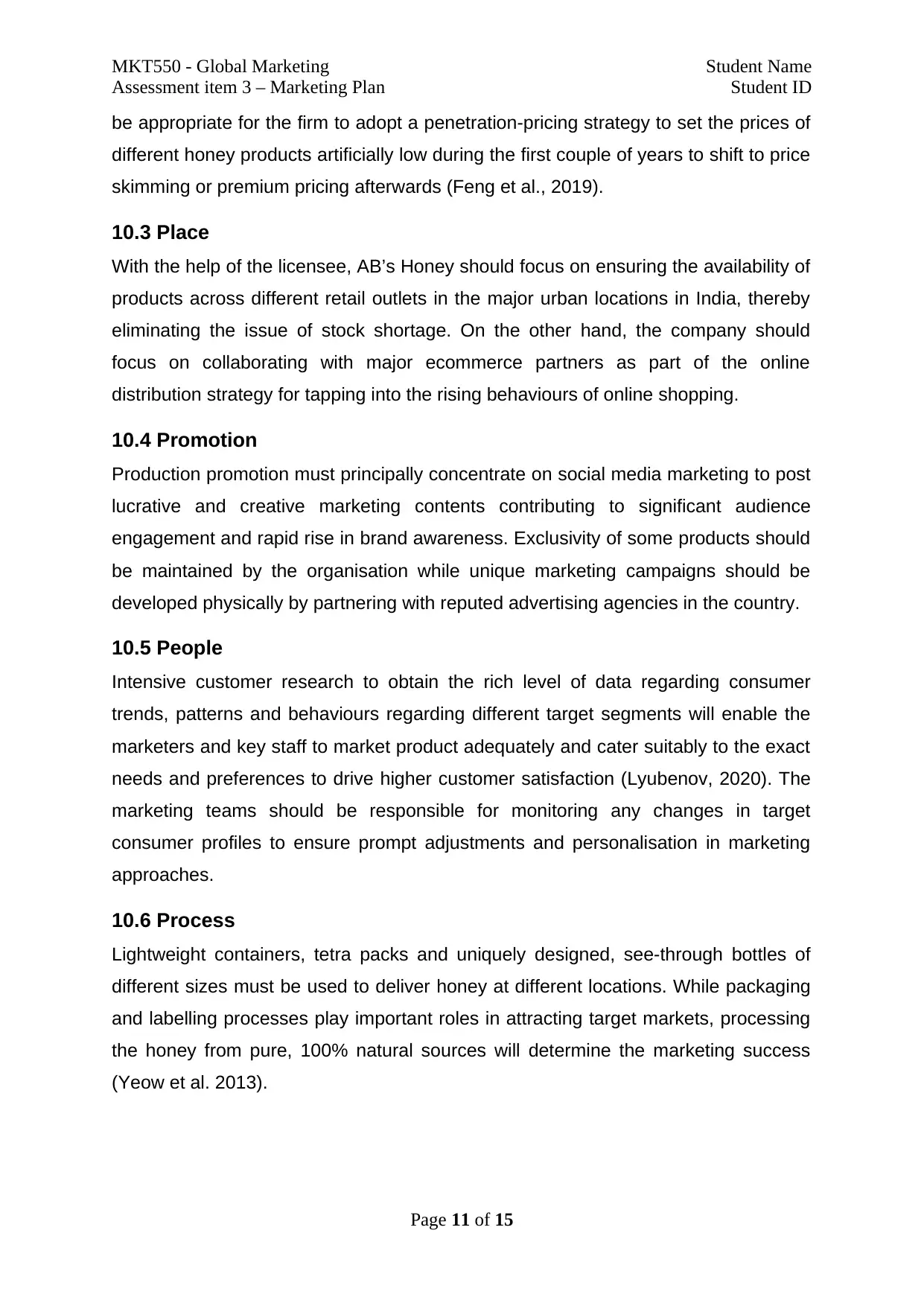
MKT550 - Global Marketing Student Name
Assessment item 3 – Marketing Plan Student ID
be appropriate for the firm to adopt a penetration-pricing strategy to set the prices of
different honey products artificially low during the first couple of years to shift to price
skimming or premium pricing afterwards (Feng et al., 2019).
10.3 Place
With the help of the licensee, AB’s Honey should focus on ensuring the availability of
products across different retail outlets in the major urban locations in India, thereby
eliminating the issue of stock shortage. On the other hand, the company should
focus on collaborating with major ecommerce partners as part of the online
distribution strategy for tapping into the rising behaviours of online shopping.
10.4 Promotion
Production promotion must principally concentrate on social media marketing to post
lucrative and creative marketing contents contributing to significant audience
engagement and rapid rise in brand awareness. Exclusivity of some products should
be maintained by the organisation while unique marketing campaigns should be
developed physically by partnering with reputed advertising agencies in the country.
10.5 People
Intensive customer research to obtain the rich level of data regarding consumer
trends, patterns and behaviours regarding different target segments will enable the
marketers and key staff to market product adequately and cater suitably to the exact
needs and preferences to drive higher customer satisfaction (Lyubenov, 2020). The
marketing teams should be responsible for monitoring any changes in target
consumer profiles to ensure prompt adjustments and personalisation in marketing
approaches.
10.6 Process
Lightweight containers, tetra packs and uniquely designed, see-through bottles of
different sizes must be used to deliver honey at different locations. While packaging
and labelling processes play important roles in attracting target markets, processing
the honey from pure, 100% natural sources will determine the marketing success
(Yeow et al. 2013).
Page 11 of 15
Assessment item 3 – Marketing Plan Student ID
be appropriate for the firm to adopt a penetration-pricing strategy to set the prices of
different honey products artificially low during the first couple of years to shift to price
skimming or premium pricing afterwards (Feng et al., 2019).
10.3 Place
With the help of the licensee, AB’s Honey should focus on ensuring the availability of
products across different retail outlets in the major urban locations in India, thereby
eliminating the issue of stock shortage. On the other hand, the company should
focus on collaborating with major ecommerce partners as part of the online
distribution strategy for tapping into the rising behaviours of online shopping.
10.4 Promotion
Production promotion must principally concentrate on social media marketing to post
lucrative and creative marketing contents contributing to significant audience
engagement and rapid rise in brand awareness. Exclusivity of some products should
be maintained by the organisation while unique marketing campaigns should be
developed physically by partnering with reputed advertising agencies in the country.
10.5 People
Intensive customer research to obtain the rich level of data regarding consumer
trends, patterns and behaviours regarding different target segments will enable the
marketers and key staff to market product adequately and cater suitably to the exact
needs and preferences to drive higher customer satisfaction (Lyubenov, 2020). The
marketing teams should be responsible for monitoring any changes in target
consumer profiles to ensure prompt adjustments and personalisation in marketing
approaches.
10.6 Process
Lightweight containers, tetra packs and uniquely designed, see-through bottles of
different sizes must be used to deliver honey at different locations. While packaging
and labelling processes play important roles in attracting target markets, processing
the honey from pure, 100% natural sources will determine the marketing success
(Yeow et al. 2013).
Page 11 of 15
⊘ This is a preview!⊘
Do you want full access?
Subscribe today to unlock all pages.

Trusted by 1+ million students worldwide
1 out of 15
Related Documents
Your All-in-One AI-Powered Toolkit for Academic Success.
+13062052269
info@desklib.com
Available 24*7 on WhatsApp / Email
![[object Object]](/_next/static/media/star-bottom.7253800d.svg)
Unlock your academic potential
Copyright © 2020–2025 A2Z Services. All Rights Reserved. Developed and managed by ZUCOL.




